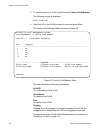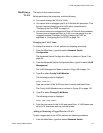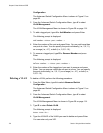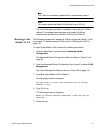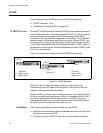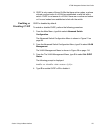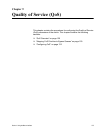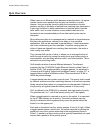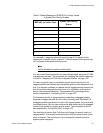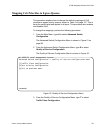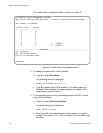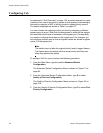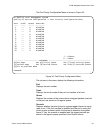
Chapter 9: Quality of Service (QoS)
126 Section I: Using the Menus Interface
QoS Overview
When a port on an Ethernet switch becomes oversubscribed—its egress
queues contain more packets than the port can handle in a timely
manner—the port may be forced to delay the transmission of some
packets, resulting in the delay of packets from reaching their destinations.
A port may be forced to delay transmission of packets while it handles
other traffic, and, in some situations, some packets destined to be
forwarded to an oversubscribed port from other switch ports may be
discarded.
Minor delays are often of no consequence to a network or its performance.
But there are applications, referred to as delay or time sensitive
applications, that can be impacted by packet delays. Voice transmission
and video conferencing are two examples. If packets carrying data for
either of these are delayed from reaching their destination, the audio or
video quality may suffer.
This is where QoS can be of value. It allows you to manage the flow of
traffic through a switch by having the switch ports give higher priority to
some packets, such as delay sensitive traffic, over other packets. This is
referred to as prioritizing traffic.
QoS actually consists of several different elements. The element
supported by the AT-9000/24 Gigabit Ethernet Switch is called Class of
Service (CoS). CoS applies primarily to tagged packets. As explained in
“Incoming and Outgoing Tagged and Untagged Frames” on page 107, a
tagged packet contains information within it that specifies the VLAN to
which the packet belongs.
A tagged packet can also contain a priority level. This priority level is used
by network switches and other networking devices to know how important
(delay sensitive) that packet is in comparison to other packets. Packets of
a high priority are typically handled before packets of a low priority.
CoS, as defined in the IEEE 802.1p standard, has eight levels of priority.
The priorities are 0 to 7, with 0 the lowest priority and 7 the highest.
When a tagged packet is received on a port on the switch, it is examined
by the AT-S84 software for its priority. The switch software uses the
priority to determine which egress priority queue the packet should be
stored in on the egress port.
Each port on the switch has four priority queues, 0 (low) to 3 (high). When
a tagged packet enters a switch port, the switch responds by placing the
packet into one of the queues according to the assignments shown in
Table 2. A packet in a high priority queue is typically transmitted out a port
sooner than a packet in a low priority queue.



